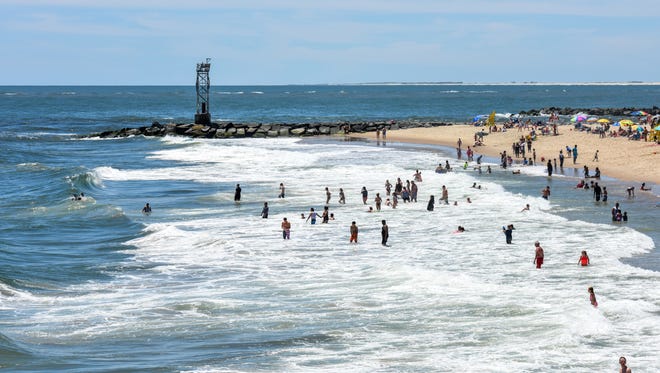Sea lice irritate swimmers with itching, rash

Alongside sunburns and insects, swimmers on Delmarva can also add "sea lice" to their list of common beach nuisances.
Both the Ocean City Beach Patrol and Assateague State Park put out social media notices this week warning swimmers to watch out for these pests.
The Facebook post from the beach patrol explaining that the unit has been fielding several calls about this "discomfort," which is plaguing beaches throughout the Eastern Seaboard, has garnered more than 300 comments and 900 shares on Facebook.
In June, reports of "sea lice," which health officials identified as tiny jellyfish larvae or jellyfish cells, also gained lots of attention along Florida beaches, where the region's annual seaweed bloom can harbor the bothersome creatures.
In a scientific context, Jonathan Cohen, an assistant professor for the University of Delaware's Department of Marine Biosciences, said sea lice refers to a type of small parasitic crustacean, or copepod, that attaches itself to fish.
However, he explained it's also a popular catch-all term used among beachgoers to describe a variety of irritants they might encounter in the water.
"So they could be small jellyfish. They could be other small crustacean," he said. "Those tend to be the common culprits, but not necessarily the same sort of parasitic copepods that are referred to as sea lice."
Though the informal name may sound alarming, Assateague State Park Manager Angela Baldwin said this "naturally occurring phenomenon" has no relation to the kind of lice parents fear children bringing home.
READ MORE:'Swimmer's itch' parasite found near Cape Henlopen fishing pier
What the park has been increasingly answering questions about this week are actually small jellyfish larvae, which can get caught between a swimmer's bathing suit and skin and cause itching or even a rash.

"It's actually just given that name (sea lice) because of the appearance. They appear to look similar," Baldwin said. "We recommend for folks to just treat it as you would a rash of another kind and that you should rinse really well and definitely rinse between your bathing suit and skin."
On Thursday afternoon, she said this common nuisance is expected to persist through at least the end of the week, but in the past, has lasted from one week to several weeks and may not be quite as dense every day.
Reports of sea lice among beachgoers occur just about every year when the water is warmer, she said, and the duration depends on water and wind conditions.
"It's hard to say because they tend to be here while the waters are warmer, but they can certainly check with the park or check with the lifeguards when they come to the beach and see if they're still continuing to get reports about it," Baldwin said.
READ MORE: As Delaware coastal waters warm, risk of deadly bacteria rises
Many swimmers, particularly in Ocean City, have also been posting to social media about encountering crab larvae, which is another type of common irritant that Cohen said can fall under the popular label "sea lice."

"This time of year is when crab larvae, they develop in the coastal ocean for many crab species," he said. "They come from the estuaries. The larvae go off into the coastal ocean of the Atlantic and they'll come back to the coast after about a month."
Both small jellyfish and crabs can typically pop up in late summer headed into fall, he said, and if wind conditions are just right, they may move these organisms further inshore, leading to the reports of "sea lice" officials have been hearing.
READ MORE:H2Oi car show has left, but Ocean City is ready anyway
READ MORE:Viking ship sailing into Ocean City for tours
Every few years or so, Cohen said "sea lice" tend to find their way into broader discussion, with a mixture of the organisms' lifecycles and local oceanographic conditions fueling their increased interaction with swimmers.
"As it gets colder and we move out of sort of the summertime and get into the colder months, then those conditions really aren’t there for those animals," he said.
Tips on avoiding sea lice:
- Pay attention to local beach reports and posted messages and avoid the water if sea lice are present and you are particularly susceptible to skin irritations.
- Avoid wearing a T-shirt or one-piece bathing suit in the ocean to limit the surface area that could trap larvae.
- There is some evidence that use of a topical sunscreen or suntan lotion may actually protect skin from penetration by the lice.
- After exiting the water, change out of your bathing suit as soon as possible. After you remove your bathing suit, shower with warm water. Do not shower in a bathing suit that has been exposed to sea lice.
- Wash your bathing suit thoroughly with detergent and then use heat to dry it. Air drying isn't enough.
Source: USA Today Network/Florida Department of Public Health